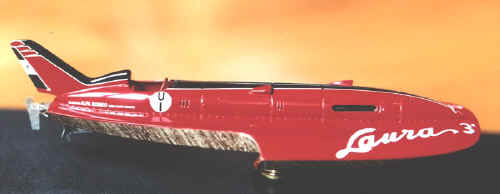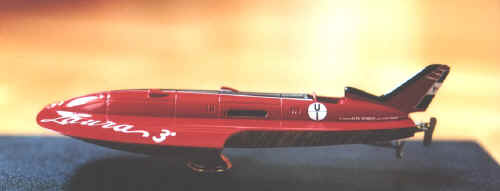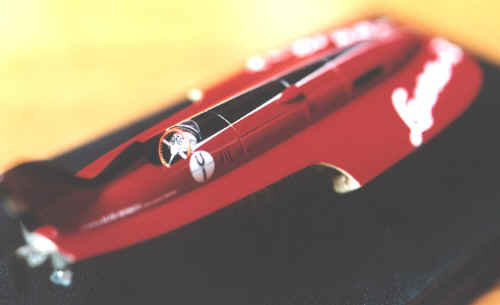|
|||||
In 1954 Italian Mario Verga wanted to bring the World Water Speed record to Italy, and he commissioned a racer to be built, using 2 Alfa Romeo 159 Grand Prix engines. Although very promising from the start, and having achieved speeds in excess of 290 kmh, his venture came to a tragic end on october 9th, 1954 when the boat somersaulted during a record attempt, allegedly travelling at over 300 kmh. Verga was killed on the spot.
The kit Being very interested in Speed Record vehicles, especially land and sea, I was really happy to see that Provence Moulage had taken to make kits of these racers, even if most of them didn't really go record-breaking. From the start I had to have these kits. Building I built this model straight from the box, except for the engine access hatch fasteners, which are molded onto the hull, and which I replaced with silver wire. I would, though, recommend to alter the shape of the small triangular fairing at the bottom of the hull, where the drive-shaft emerges from the hull, as the angle at which the driveshaft enters the fairing does not match the angle of the latter (see pictures for clarity).
The only tricky part is the painting of the hull, as you will want to paint it in two colours : Red for the upper hull, and something like " light wood " or " pale sand " for the lower hull. Onto this lighter colour, you will later apply the wood veneer decals, which are in fact dark brown " veneer-stripes ", printed onto clear decal film. The final effect is quite good, and much faster than trying to replicate the same effect with painting.
I then masked the whole model using stretchable Parafilm-M, and re-primed the lower hull with a light tan primer/filler. The lower hull decals were applied using Solvaset. To give it a nice shine, I applied Tamyia Modeling Wax to these areas. Meanwhile I had also prepared and painted the accessories like interior (seat, dashboard and steering-wheel), driveshaft and propeller, and rudder assembly. The latter is built up from p-e parts ; I lightly sanded these on a piece of fine sanding paper, which I have glued to a piece of flat glass. This sanding cuts the chrome-like sheen of the p-e parts. Assembly is a bit tricky due to the size (or rather lack of such ;-) of the parts involved, but it all fits very nicely together.
I always liked the " classic " presentation of the larger wooden ship models, which are often put on brass stands ; the local hardware store had a nice selection of drawer-knobs, from which I chose one. Conclusion I can recommend this kit, and many others from the Provence Moulage range, even for beginners. They are nice subjects, well done, and most of them are easy to assemble and paint. Most of them are powered by engines bearing prestigious names, from Ferrari to Isotta-Frascini, from Bugatti to Jaguar, and are a nice addition to any automobilia model collection.
References
Special tools and supplies used
The pictures were taken before I had fitted the new engine access hatch fasteners |


